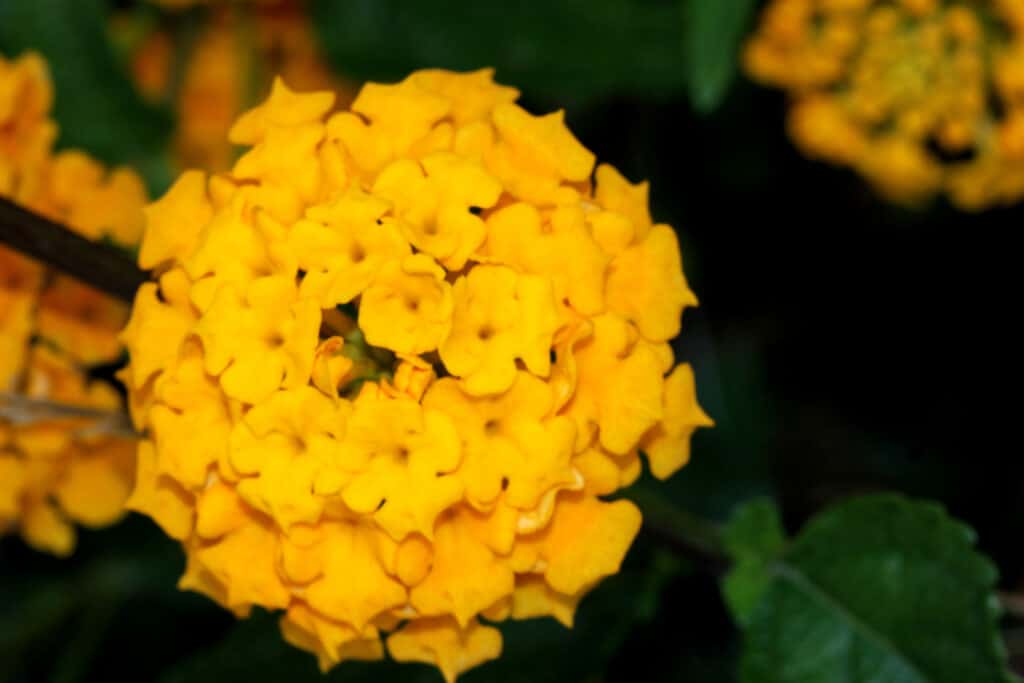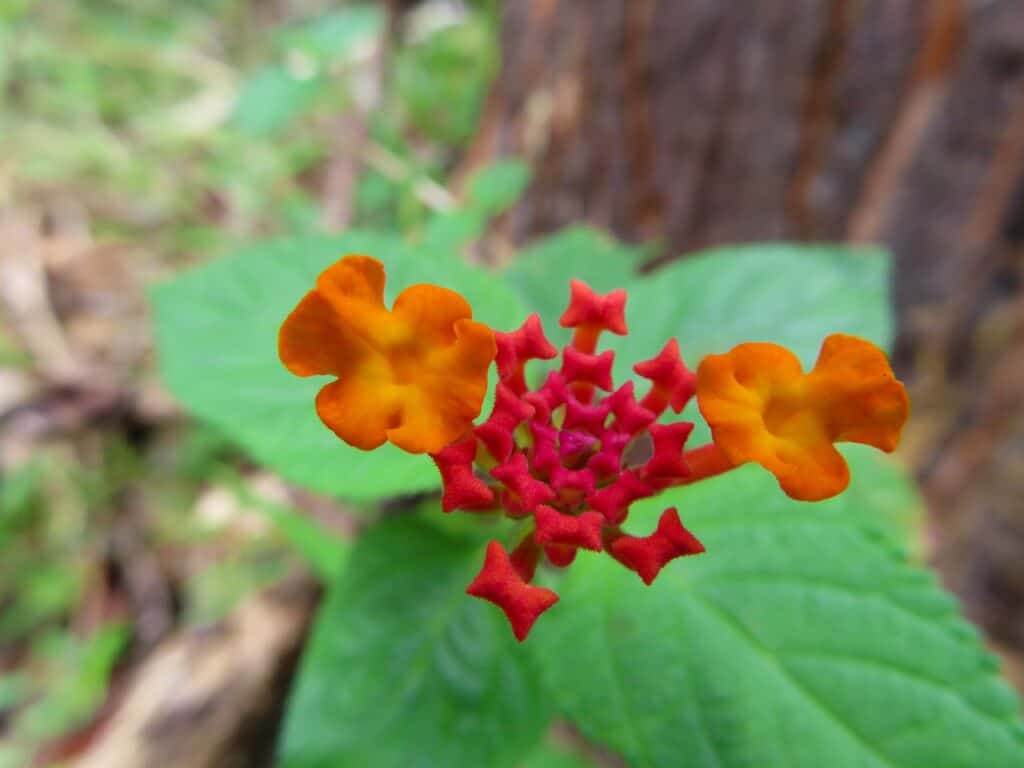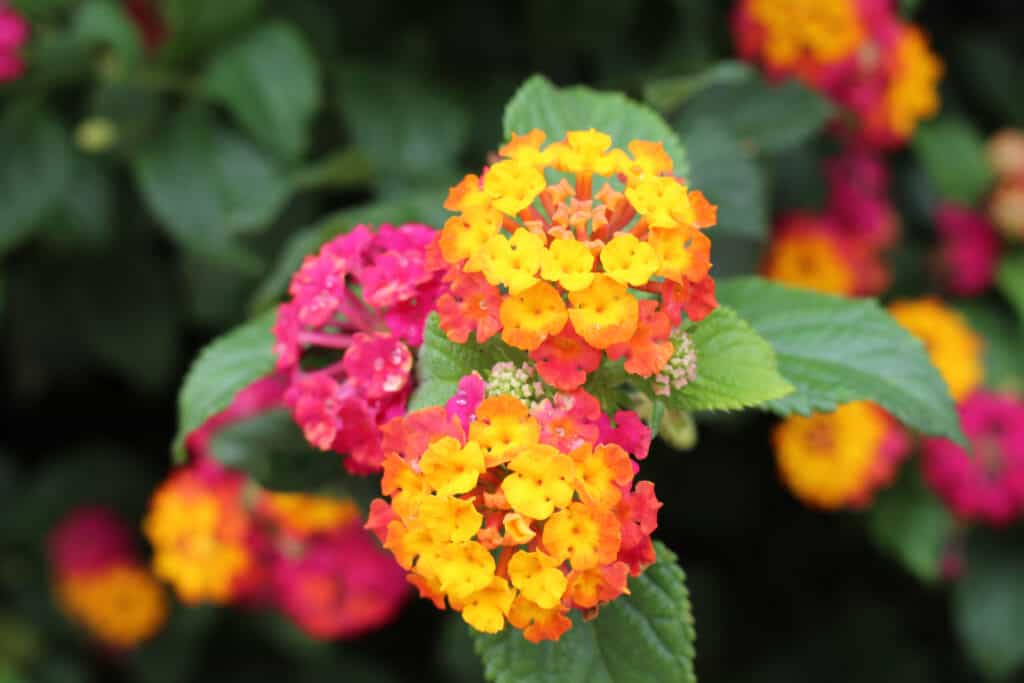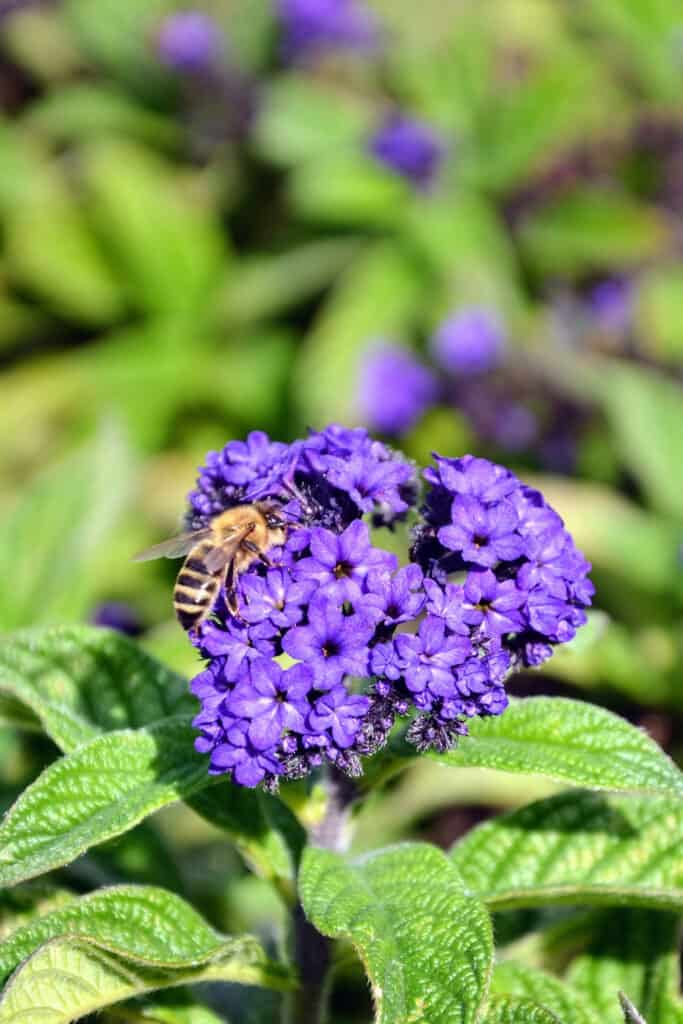There are literally dozens of varieties of lantana plants, but there are two primary types: mounding lantana vs. trailing lantana. While both are decorative, their differences will help you determine which fits your needs.
| Mounding Lantana | Trailing Lantana | |
|---|---|---|
| Classification | Lantana camara; over 150 varieties of lantana, with nearly endless cultivars | Lantana montevidensis; over 150 varieties of lantana, with nearly endless cultivars |
| Description | These herbaceous perennials may grow up to 6 feet in height and spread as far as 1.5 feet. They have silvery-green leaves rising from short stems and produce small silver, yellow, or white flowers. | Trailing lantana tends to be sprawling up to 6 feet in height and spread, with vine-like qualities to them. They produce purple, pink, yellow, and bicolor flowers and dark green leaves. |
| Uses | Mounding lantana are low-profile plants used for decorative appearances, pollinator gardens, container plants, and erosion protection. | Lantana has many uses and in past was largely considered useful for herbal medicines. Some studies in Indian have shown this, while certain cultural groups have turned the berries into edible dishes and garnishes like jams and pies. |
| Origins and growing preferences | Lantana comes from Central and South America originally, with export to Australia in the 1840s. The plant needs full to partial shade in Zones 8 to 12, with well-draining soil. | Trailing lantana, like mounding lantana, originated in Central and South America. The plant does best in full to partial shade, in well-drained soil, and should be planted in infertile soil to keep its pristine looks. |
| Special features and fun facts | Lantana plants are salt resistant, making them great for coastal gardens and homes. They’re also drought-resistant, which makes them great for arid climates as well. | The leaves of the lantana plant are toxic for most animals and humans, yet the berries (of some varieties) are edible and favored for cordials and jellies. |

“Gold mound” mounding lantana has dark, marigold shade flowers in some cases, with darker leaves.
©Gurcharan Singh/Shutterstock.com
Key Differences Between Mounding Lantana and Trailing Lantana
Mounding lantana vs. trailing lantana have similar-looking flowers but otherwise, there aren’t that many similarities in their looks. However, they have many common uses and characteristics that could be handy to know. Check them out below and see which variety(s) might be best for your home and garden use.
Mounding Lantana vs. Trailing Lantana: Classification

Trailing lantana is also known as weeping or creeping lantana.
©midfield man/Shutterstock.com
Lantana is part of the Asteraceae family, or daisy family. The mounding variety (Lantana camara) of the plant is known commonly simply as lantana or may be called Angels Hair, mounding lantana, or wormwood. The trailing variety (Lantana montevidensis) is known as lantana, trailing lantana, weeping lantana, small lantana, purple lantana, creeping lantana, or trailing shrub verbena. Lantanas are evergreen plants, with some classed as broadleaf. Some varieties function well as ground cover.
Mounding Lantana vs. Trailing Lantana: Description

Trailing lantana tends to spread out quite a bit more than mounding lantana.
©logoboom/Shutterstock.com
Lantana plants are herbaceous perennials that may grow up to 6 feet tall, depending on the cultivar. Typically, they spread out to about 1 or 1.5 feet wide. Mounding lantana has alternating silvery-green leaves that rise from short stems and are divided into linear segments of fine textured surfaces. The leaves tend toward more silver shades in autumn and quickly die back to the crown after the first frost or two. The mounding lantana may have silver, orange, dark yellow, pale yellow, or white flowers and are often unnoticed because of the larger, most prevalent silver foliage in some species (particularly the silver mounding species).
Trailing lantana, on the other hand, tends to be much more sprawling in appearance, spreading out up to 2 feet and appearing more shrub/vine hybrid-like. The flowers on trailing lantana are purples, pinks, lilacs, and sometimes bicolor with yellows and red or pink shades. The leaves are oval-shaped and generally dark green with tiny hairs on them. These do best when planted along fences, lattices, and similar areas where they can easily climb.
Mounding Lantana vs. Trailing Lantana: Uses

Lantana in the wild may come in a wide range of colors, including bicoloration.
©Karinisme/Shutterstock.com
Mounding lantana is considered a low-profile growth plant. From spring to fall the silver mounding plant buds with small flowers, adding to its decorative appearance, and drawing butterflies, bees, and other pollinators.
Both mounding and trailing lantana is seen as having many uses, including placement in erosive soils in California to prevent further erosion. Because of the fast nature of its growth, it keeps the soil from fading away once the plants are well established.
Some medical studies in India have shown that lantana leaves may provide antimicrobial resistance, fungicidal, and insecticidal uses. It has also been used in traditional herbal medicines for many centuries, treating things like rabies, chickenpox, measles, ulcers, asthma, stress, and high blood pressure. There are no definitive studies on these, however, so, as always, you should consult with a medical care provider before partaking of any plant for medicinal purposes. It should be specifically noted that the leaves of lantana plants are generally considered toxic for both humans and animals. Some varieties of the plants, on the other hand, have edible berries which are used in various culinary uses in Ecuador and similar cultures.
Lantana is most often grown for ornamental purposes and pollinator gardens. Because the plants grow quickly, they make for great fence edging, woodland margins, and specimen plants. Some types of weaver birds also use the flowers to decorate their nests in the springtime. The purple lantana also is often planted as drought-tolerant ground cover, woody vine, and hanging plants.
Mounding Lantana vs. Trailing Lantana: Origins and Growing Preferences

Lantana may come in pale or vivid shades ranging from white or cream to bold pinks and oranges.
©Johanna Weber/Shutterstock.com
Lantana is a large shrub that flowers and grows natively in subtropical climates in Central and South America. The plant was exported to Australia in the 1840s for ornamental use, but it was quickly discovered to be invasive, as it quickly overtook domestic cultivation of other plants. Within 20 years, it was established in the wild there. The plant overtook nearly 1000 miles of coastline in Eastern Australia within just 100 years.
You may opt to grow your lantana plants from seeds or from established plants from nurseries and garden centers. You’ll find many varieties of the plant available both in-person and online. The different varieties of both mounding and trailing lantana have different needs, but the majority of the plants in this family thrive in Zones 8 to 12, in full sun to partial sun, depending on the heat of the environment. Plant them in moist, well-drained soil. Infertile soil is best because it prevents excessive vertical growth (mounding lantana) which leads to opening and separating by mid-September.
Mounding Lantana vs. Trailing Lantana: Special Features and Fun Facts

Lantana flowers may have bicolor form in multiple ways, including white with yellow centers.
©Ibenk_88/Shutterstock.com
Lantana plants have a bunch of fun and interesting facts and features that help to make them intriguing and enticing at once for gardeners, both indoors and out. For one, they’re both salt-resistant (i.e., great for coastal gardens!) and drought-resistant (i.e., great for arid climates). The plant is also fire resistant – or at least tolerates fire. It regenerates from basal shoots after fires consume the plant. Lantana appears in folklore where it helps heal snake bites, chickenpox, and other skin irritations and eruptions. Plus, their berries are edible and often used for jams, jellies, pies, and cordials in Ecuador.
However, the leaves are poisonous to most animals, so don’t keep them indoors with pets. And, sadly, lantana plants are an extremely invasive species in Australia that places the mahogany glider species at risk.

Honeybees and other pollinators love lantana blooms.
©PaulSat/Shutterstock.com
Does Lantana Do Well in Pots, Boxes, and Baskets?
Both types of lantana can thrive in containers like pots, flower boxes, or hanging baskets. Use mounding lantana in upright containers and combine with perennials like milkweed or coneflowers. Varieties that do well in pots include Dallas Red, Landmark™ Citrus, or Luscious® Goldengate™.
If hanging baskets for flower boxes are your thing, dwarf lantana is a good option as it only grows from 8-24 inches wide/tall on average, taking up less space than the typical 36 inches of length. Good trailing choices include purple trailing verbena, Luscious Grape®, or Spreading Sunset™. They can successfully share space with Patriot™ Rainbow Compact, Little Lucky™ Red, or Bandana® Lemon Zest.
The photo featured at the top of this post is © midfield man/Shutterstock.com
Sources
- Plant Snap, Available here: https://www.plantsnap.com/plantblog/types-of-lantana/
- Almost Eden, Available here: https://www.almostedenplants.com/shopping/products/10896-silver-mound-lantana-mounding-white/
- Ohio State University - Plant Facts, Available here: https://plantfacts.osu.edu/tmi/Plantlist/ar_tiana.html
- Online Plant Guide, Available here: https://www.onlineplantguide.com/Plant-Details/1460/
- Ball Seed, Available here: https://www.ballseed.com/PlantInfo/?phid=036900001005081
- Wikipedia, Available here: https://en.wikipedia.org/wiki/Lantana_montevidensis
- HGTV, Available here: https://www.hgtv.com/outdoors/flowers-and-plants/trailing-lantana-lantana-montevidensis
- NSW Department of Planning and Environment, Available here: https://www.environment.nsw.gov.au/topics/animals-and-plants/pest-animals-and-weeds/weeds/widespread-weeds/lantana
- Gardenerdy, Available here: https://gardenerdy.com/interesting-facts-about-lantana-flowering-plant/
Thank you for reading! Have some feedback for us? Contact the AZ Animals editorial team.






